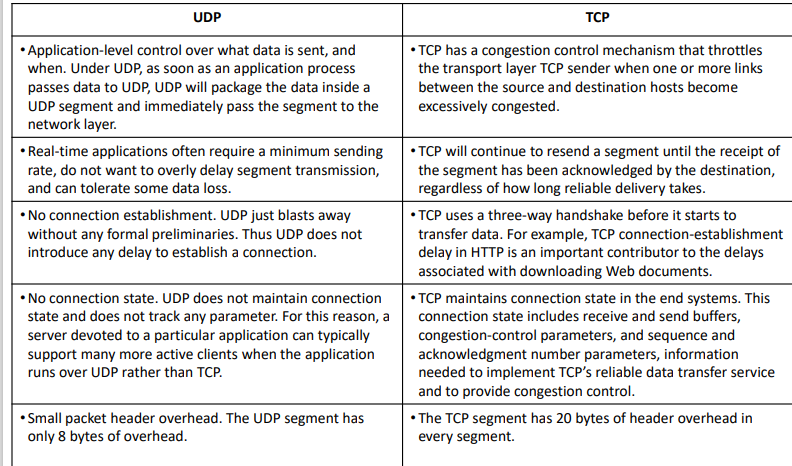Transport Layer
5.0(1)
5.0(1)
Card Sorting
1/88
Earn XP
Description and Tags
transport layer services and protocols/ multiplexing and demultiplexing/ TCP and UDP
Study Analytics
Name | Mastery | Learn | Test | Matching | Spaced |
|---|
No study sessions yet.
89 Terms
1
New cards
what is the transport layer?
transport layer provides logical communication between 2 processes on different hosts, the protocols are implemented in the end systems but not network routers
2
New cards
what is the network layer?
*network layer* provides logical communication between 2 hosts
3
New cards
what is the packet terminology per layer?
* application = message
* transport = segment
* network = datagram
* link = frame
* transport = segment
* network = datagram
* link = frame
4
New cards
how does the transport layer relate to the network layer?
transport layer relies on the network layer and enhances the existing network layer services. \[via the IP Service Model\]
5
New cards
how does the transport layer work in the IP stack? \[sending side- sent TO the transport layer\]
* transport layer (TL) converts messages from the application layer into segments ^^by breaking down the message into chunks and adding a transport layer header -^^ ==encapsulation==
* ^^TL passes the segment to the network layer (NL)^^ where the segment is encapsulated into a datagram and sent to the destination
* ^^TL passes the segment to the network layer (NL)^^ where the segment is encapsulated into a datagram and sent to the destination
6
New cards
how does the transport layer work in the IP stack? \[receiving side - data received back up from network layer\]
* NL extracts the TL segment from the datagram and passes it up to the TL
* TL processes the segment and makes the data available to receiving application
* TL processes the segment and makes the data available to receiving application
7
New cards
how do network routers relate to the transport layer?
network routers act on the NL only and do not examine the encapsulated TL segment fields
8
New cards
what are the 2 transport protocols available for the applications on application layer to use?
* UDP - unreliable, unordered delivery
* TCP - reliable, in-order delivery
these transport protocols from the transport layer provide ==transport services==
* TCP - reliable, in-order delivery
these transport protocols from the transport layer provide ==transport services==
9
New cards
what services does the transport layer provide to the application layer?
* ==process-level addressing==
* ==multiplexing and demultiplexing==
* ==integrity checking==
* %%connection management (establishment and termination)%%
* %%acknowledgements and retransmissions%%
* %%flow control%%
* %%congestion control%%
\
these services are provided by a combination of UDP and TCP specific services
* ==multiplexing and demultiplexing==
* ==integrity checking==
* %%connection management (establishment and termination)%%
* %%acknowledgements and retransmissions%%
* %%flow control%%
* %%congestion control%%
\
these services are provided by a combination of UDP and TCP specific services
10
New cards
which of the transport services are specific to TCP services only?
* connection management (establishment and termination)
* acknowledgements and retransmissions
* flow control
* congestion control
* acknowledgements and retransmissions
* flow control
* congestion control
11
New cards
what is process-level addressing?
TL differentiates between processes on applications, but the network layer identifies the actual hosts
12
New cards
what is multiplexing and demultiplexing?
used to pass data between correct application-level process and network, happens regardless of which protocol is used
13
New cards
what is integrity checking?
error detection for when data is sent
14
New cards
when is connection management (establishment and termination) provided?
provided if using a ^^connection-oriented^^ protocol (TCP)
15
New cards
when is acknowledgments and retransmissions provided?
provided if using a ^^reliable^^ service (TCP)
16
New cards
when is flow control provided?
provided if using an ^^in-order delivery^^ service (TCP)
17
New cards
how does multiplexing and demultiplexing relate to the network layer?
MUX and DMUX at transport layer enhances an existing network layer service
* enhaces the existing **host-to-host** delivery service into a **process-to-process** delivery service
* enhaces the existing **host-to-host** delivery service into a **process-to-process** delivery service
18
New cards
where does multiplexing take place?
on the sending host
19
New cards
what is multiplexing?
* process of gathering data chunks from different sockets, encapsulating each chunk into segments and passing segments to the network layer
* data can be sent all in one go
* data can be sent all in one go
20
New cards
where does demultiplexing take place?
on the destination host
21
New cards
what is demultiplexing?
unwrapping the received segments and delivering them to the correct socket
22
New cards
why do sockets need a unique identfier?
receiving host can have many sockets so each socket has a unique identifier
23
New cards
what impacts the format of the socket identifier?
the type of socket used
* UDP socket for ==connectionless== demultiplexing
* TCP socket for ==connection-oriented== demultiplexing
* UDP socket for ==connectionless== demultiplexing
* TCP socket for ==connection-oriented== demultiplexing
24
New cards
what is the UDP socket identifier made up of?
* destination ip address
* destination port number
* destination port number
25
New cards
what is the TCP socket identifier made up of?
* source ip address
* source port number
* destination ip address
* destination port number
* source port number
* destination ip address
* destination port number
26
New cards
what does the host use to demultiplex a segment?
when (UDP or TCP) segment arrives from network to host, the host uses the type of socket, and its identifier to demultiplex the segment to the correct socket
27
New cards
how does demultiplexing occur if there are 2 segments with different source addresses but the same destination address?
* using UDP = send both segments to the same destination process using the same socket
* using TCP = send the segments to 2 separate sockets that are both made for the same process
* using TCP = send the segments to 2 separate sockets that are both made for the same process
28
New cards
how do web servers use port numbers?
* well known servers are used by http and have registered socket numbers eg. web server has port number 80
* when a client sends segments to a server all the segments (containing the initial connection request and all other requests) have the same destination port number \[80\]
* server differentiates segments from different clients using source socket identifier
* when a client sends segments to a server all the segments (containing the initial connection request and all other requests) have the same destination port number \[80\]
* server differentiates segments from different clients using source socket identifier
29
New cards
what type of correspondence can a client have with a web server?
* one to one correspondence
* multithreading
* multithreading
30
New cards
what is one on one correspondence?
* each connection with a client causes the web server to spawn a new process
* each process has its own connection socket that can sent and receive HTTP requests
* each process has its own connection socket that can sent and receive HTTP requests
31
New cards
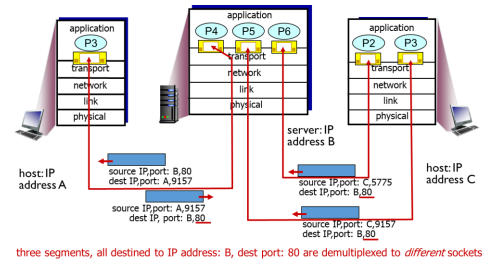
explain this image of one to one correspondence
* P3 is a process, with a corresponding socket underneath
* server has 3 connections, therefore 3 processes are spawned, and a socket is assigned to each process
* server has 3 connections, therefore 3 processes are spawned, and a socket is assigned to each process
32
New cards
why is multithreading used?
to prevent servers being overloaded with one on one requests servers can use multithreading
33
New cards
what is multithreading?
only 1 process is created and within that process new threads are created and attached to that process. each thread has a connection socket used for a client connection. as usual each socket has its own socket identifier
34
New cards
what is a thread?
a lightweight sub-process
35
New cards
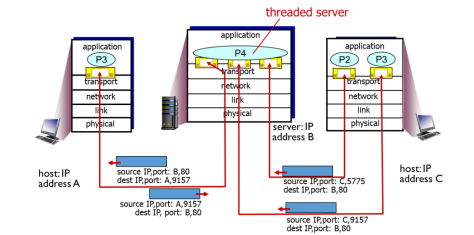
explain this image of multithreading
the server is now a threaded server, and only contains one process \[P4\] that has 3 threads attached which each have their own socket. for 3 client connections, they each use different sockets that are part of the same process
36
New cards
how does UDP - connectionless transport work?
* take messages (payload) from application process - attaches source and destination port # for mux/demux, length, and checksum, and passes segment to network layer
* if segment arrives at host, UDP uses destination port # to deliver to correct socket
* if segment arrives at host, UDP uses destination port # to deliver to correct socket
37
New cards
which services does UDP provide?
* process-level addressing
* multiplexing and demultiplexing
* light error checking
* multiplexing and demultiplexing
* light error checking
38
New cards
what is the structure of a UDP segment?
width 32 bits is relative to field size, eg. source port # is 16 bits, dest port # is 16 bits
header = 8 bytes
header = 8 bytes
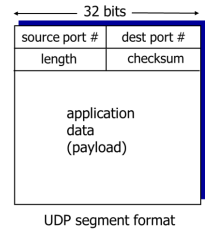
39
New cards
what is the length field?
number of byes in UDP segment (including both header & payload)
* needed because size of payload differs from segment to segment
* needed because size of payload differs from segment to segment
40
New cards
what is the checksum field?
used by receiving host to check if the segment has errors
* sender treats segment content as a sequence of ==16-bit== integers and uses this to calculate the checksum for that segment (one’s complement sum of segment content)
* receiver recalculates the checksum and checks if this matches the checksum field
* sender treats segment content as a sequence of ==16-bit== integers and uses this to calculate the checksum for that segment (one’s complement sum of segment content)
* receiver recalculates the checksum and checks if this matches the checksum field
41
New cards
what are the **features** of TCP - connection oriented transport?
* processes must handshake to establish connection
* three way handshake procedure
* has a logical connection
* provides full-duplex service
* always point to point
* three way handshake procedure
* has a logical connection
* provides full-duplex service
* always point to point
42
New cards
explain the feature: *processes must handshake to establish connection*
preliminary segments are sent to each other to ==establish the parameters of the resultant data transfer==
both sides will initialise many ==TCP state variables== regarding the TCP connection
both sides will initialise many ==TCP state variables== regarding the TCP connection
43
New cards
explain the feature: *three way handshake procedure*
* ==client== sends special TCP segment to server asking to initiate connection (no payload)
* %%server%% respond with special TCP segment to initiate or not (no payload)
* ==client== sends special TCP segment (may contain payload)
* %%server%% respond with special TCP segment to initiate or not (no payload)
* ==client== sends special TCP segment (may contain payload)
44
New cards
explain the feature: *a logical connection*
TCP protocol runs on ==end systems only== and not network elements (routers) - network elements are oblivious to TCP connection occurring
45
New cards
explain the feature: *provides full-duplex service*
* application layer data can flow from process A to process B, and vice versa
* both hosts allocate a ==receive buffer== and define a ==receive window== variable
* both hosts allocate a ==receive buffer== and define a ==receive window== variable
46
New cards
explain the feature: *always point to point*
between one sender and one receiver
47
New cards
what are the different **properties** of a TCP connection?
A TCP connection consists of the set of properties:
* {buffers, variables, and a socket connected to a process}
There is a set of these properties at **each host**- meaning each host at each side of the TCP connection has it’s own send and receive buffer
* {buffers, variables, and a socket connected to a process}
There is a set of these properties at **each host**- meaning each host at each side of the TCP connection has it’s own send and receive buffer
48
New cards
what are the steps of how TCP properties are used during a TCP connection?
1. client process passes a stream of data through the socket
2. TCP running in the client directs data to the connection’s ==send buffer==
3. TCP grabs chunks of data from send buffer
4. Maximum amount of data that can be grabbed and place in segment it defined by the ==Maximum Segment Size variable (MSS)==
* max size of the payload (application data), not max size of whole TCP segment (payload & headers)
* calculate by getting length of the largest link layer frame that the host can send (==Maximum Transmission Unit - MTU==) to ensure the TCP segment encapsulated as a datagram + TCP/IP header length (40 bits) will fit in a frame
5. ^^TCP pairs each chunk of data with a TCP header to form a TCP segment^^
6. ^^segments passed to network layer^^ where they are separately encapsulated into an IP datagram
7. IP datagram is sent into the network
8. when TCP receives a segment at other host, the segment’s **payload** is placed into the connection’s ==receive buffer==
9. the application reads the stream of data from the receive buffer
\
*blue highlight represents encapsulation and multiplexing as mentioned earlier*
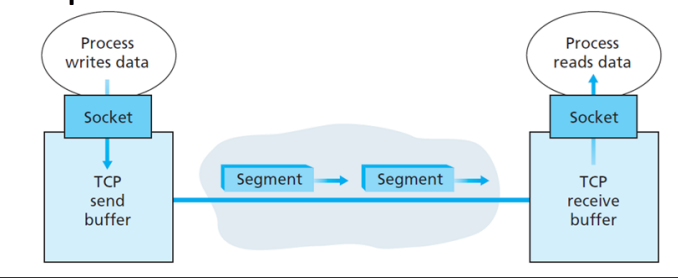
49
New cards
what is the structure of a TCP segment?
source port #
destination port #
checksum
sequence number
acknowledgement number
receive window
header length
options
flag
urgent data pointer
destination port #
checksum
sequence number
acknowledgement number
receive window
header length
options
flag
urgent data pointer
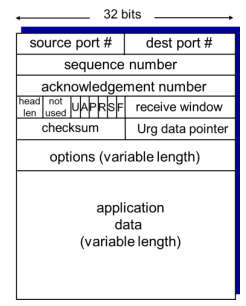
50
New cards
how does the source port #, destination port # and, checksum differ from TCP to UDP?
they don’t differ, the fields are the same
51
New cards
what TCP service is the sequence and acknowledgement numbers used for and what size are they?
used by TCP sender and receiver for reliable data transfer
both are 32 bits each
both are 32 bits each
52
New cards
what TCP service is the receive window used for and what size is it?
used for flow control
16 bits
16 bits
53
New cards
what is the header length field used for and what size is it?
shows the length of the TCP header in 32-bit words
4 bits
\
the TCP header can vary in length depending if the Options field is used or not.
if options empty then header length = 20 bytes
4 bits
\
the TCP header can vary in length depending if the Options field is used or not.
if options empty then header length = 20 bytes
54
New cards
What is the options field used for and what size is it?
optional fields used for negotiating MSS between hosts, window scaling factor for high speed networks, time stamping
has a variable length
has a variable length
55
New cards
what is the flag field used for and what size is it?
contains 6 bits where each bit has a different meaning and use
* ACK bit - means the segment contains an acknowledgement (successfully received another segment)
* RST, SYN, FIN bits - used for connection setup and teardown
* CWR, ECE bits - used in explicit congestion notification
* PSH bit - indicates receiver should push data to the upper layer immediately
* URG bit - indicates there is data in the segment that is marked by the upper layer as urgent
* ACK bit - means the segment contains an acknowledgement (successfully received another segment)
* RST, SYN, FIN bits - used for connection setup and teardown
* CWR, ECE bits - used in explicit congestion notification
* PSH bit - indicates receiver should push data to the upper layer immediately
* URG bit - indicates there is data in the segment that is marked by the upper layer as urgent
56
New cards
what is the urgent data pointer field used for and what size is it?
points to the last byte of data that is marked as urgent
16 bits
16 bits
57
New cards
how is a sequence number used?
⇒ byte-stream number of the first byte in the segment
* 500KB data (0 - 499,999) over 1KB MSS will be transmitted in 500
segments
* The first segment will have sequence number 0, the second segment will have sequence number 1,000, the third segment will have sequence number 2000, etc
* 500KB data (0 - 499,999) over 1KB MSS will be transmitted in 500
segments
* The first segment will have sequence number 0, the second segment will have sequence number 1,000, the third segment will have sequence number 2000, etc
58
New cards
how is an acknowledgement number used?
⇒ the sequence number of the next byte the receiving host is ***expecting*** from the sender host
* when a receiving host is receiving the above data, after receiving the first segment it will send a segment containing acknowledgment number 1,000.
* when a receiving host is receiving the above data, after receiving the first segment it will send a segment containing acknowledgment number 1,000.

59
New cards
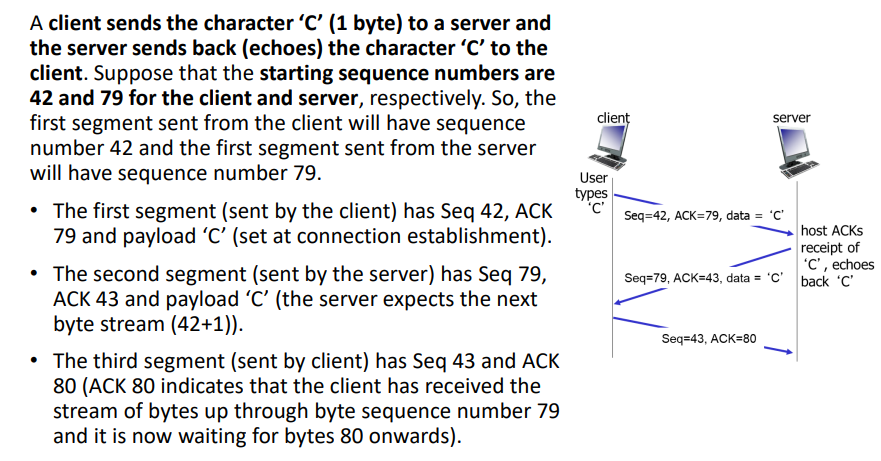
explain this image of seq and ack numbers
the acknowledgement number increment by 1 each time after each segment is sent since they are expecting segments to be sent in order - eg. server expects segment with sequence # 43, then segment with sequence # 44, client expects segment 79, then segment 80
the other host should then send a segment with the sequence number that the current host is expecting
the other host should then send a segment with the sequence number that the current host is expecting
60
New cards
what type of data transfer does IP have?
IP alone has an unreliable best-effort service
61
New cards
what is the TCP service - reliable data transfer?
TCP creates a reliable data transfer service on top of the standalone IP service
* ensures the data stream read from the receive buffer is uncorrupted
* not gaps or duplication and in-sequence
* byte stream sent is the same as the byte stream received
* ensures the data stream read from the receive buffer is uncorrupted
* not gaps or duplication and in-sequence
* byte stream sent is the same as the byte stream received
62
New cards
what are the two ways TCP carries out reliable data transfer?
timeout- triggered retransmission
fast retransmit
fast retransmit
63
New cards
what is a timeout?
a timer is started to measure the time between when a segment is sent and when an ACK for that segment is expected to be received by the sender → used to identify and recover lost segments.
64
New cards
how does a timeout work?
1. TCP starts the time when a segment is passed to IP stack as long as the timer is not already running from a previous segment
2. If the ACK segment is not received in time a timeout occurs.
3. TCP retransmits the segment that caused the timeout and restarts the timer
4. When the ACK arrives the TCP compares the ACK value with the sequence number of the oldest unacknowledged byte
5. If there are issues with the ACK number then TCP restarts the timer if there are any unacknowledged segments
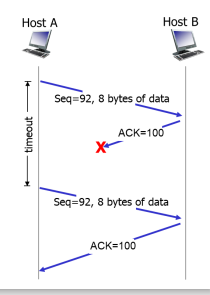
65
New cards
what are the issues with timeout-triggered retransmissions?
* if timeout period too long ⇒ when segment lost, the sender has to delay resending the lost packet which increased overall end-to-end delay
* if timeout period too short ⇒ the ACK may arrive after the timeout period causing unnecessary retransmission
* if timeout period too short ⇒ the ACK may arrive after the timeout period causing unnecessary retransmission
66
New cards
how does TCP use cumulative acknowledgements?
an ACK acknowledges the receipt of all the bytes before the byte number. based on the ACK number the TCP sender can determine if there are any segments that were not acknowledged
67
New cards
what is fast retransmission?
the TCP sender can use duplicate acknowledgements sent by the receiver to detect packet loss before the timeout occurs
68
New cards
what is a duplicate acknowledgment?
an ACK that acknowledges a segment that the sender has already received an acknowledgment for earlier on
69
New cards
how does fast retransmission work?
1. TCP receiver receives the segment and checks sequence number
2. if the sequence number larger that expected it means there’s a gap in the in-order sequence data stream thus, missing segment (eg. sequence num = 99, then 101 when expecting 100)
3. receiver reacknowlges by sending an ACK for the last in-order byte of data it received (eg. send an ACK for 101 containing ACK number = 100 instead of using ACK number = 101)
1. if sender is sending segments back to back then multiple duplicate ACKS can occur (eg. 3 segments trying to be send after the missing one, 101, 102, 103. instead of giving an ACK for each of those numbers, duplicates the ACK# = 100 3 times)
4. if sender received the duplicate ACKS - eg. 3 duplicate ACKs for 100, means that the segment with the same ACK number needs to be sent (eg. need to resend segment 100)
5. sender performs a fast retransmit of the missing segment before the segment timer expires
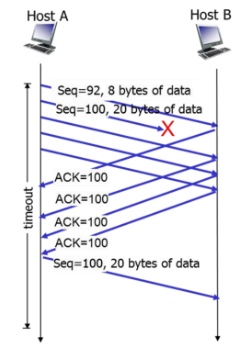
70
New cards
what is the TCP service - flow control?
a speed matching service that matches the rate at which sender is sending against rate that receiving application is reading
71
New cards
why is flow control needed?
if application is slow at reading data ten sender can overflow the connection’s receive buffer by sending too much data too quick
72
New cards
how does flow control work?
1. Sender has a variable called %%receive window%%
2. TCP is full duplex so both hosts allocate and define a %%receive window%% variable
3. when an application reads data it takes it out from the ^^receive buffer^^.
4. the receiver knows the last byte read and the last byte received. the %%receive window%% is calculated.
5. the sender uses the %%receive window%% to know how much data to send
73
New cards
what are the equations involved for flow control?
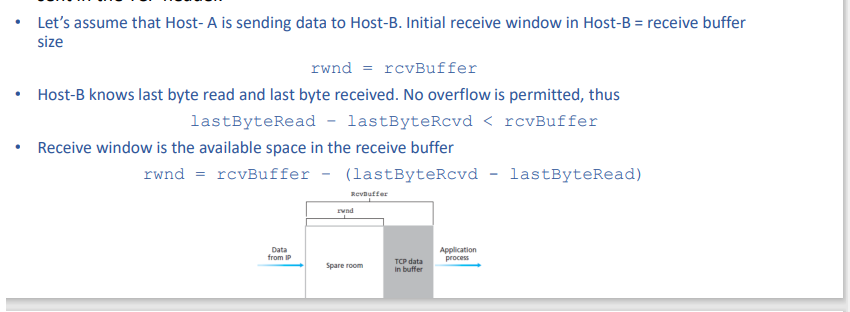
74
New cards
what is a receive buffer?
memory to store the payload of segments
75
New cards
what is a receive window?
a variable showing to the sender how much free buffer space is available at the receiver
the receive window value is sent to the TCP header and because no overflow is permitted the receive window is always ≤ receive buffer
the receive window value is sent to the TCP header and because no overflow is permitted the receive window is always ≤ receive buffer
76
New cards
what two parts make up the TCP service - connection management?
connection establishment
connection termination
connection termination
77
New cards
what is connection establishment?
a three-way handshake procedure to form a connection between 2 hosts before data can be sent
\
made up of 3 parts:
* SYN segment
* SYN/ACK segment
* ACK segment
\
made up of 3 parts:
* SYN segment
* SYN/ACK segment
* ACK segment
78
New cards
what happens in the SYN segment?
1. client sends special segment to server
1. segment contains no application layer data
2. SYNbit in header = 1
3. client randomly chooses initial sequence number to add to sequence number field (client_isn)
79
New cards
what happens in the SYN/ACK segment?
2. server receives SYN segments and allocates the TCP buffers and variables to that side of the connection
3. sends special segment to client
1. sets SYNbit = 1 in header and ACKbit = 1
2. sets ACK# to client_isn + 1 and adds to header
3. chooses random number to be initial sequence number (server_isn) and adds to header
4. sends ***connection-granted*** segment to client where SYN bit = 1
5. does not contain application layer data in payload
80
New cards
what happens in the ACK segment?
4. client receives SYN/ACK and allocates TCP buffers and variables to that side of the connection
5. sends special segment to server acknowledging that connection-granted segment
1. SYNbit = 0, ACKbit = 1, SEQ# = client_isn + 1 , ACK# = server_isn + 1
2. can contain application layer data in payload
81
New cards
this is an example of connection establishment with three-way handshake
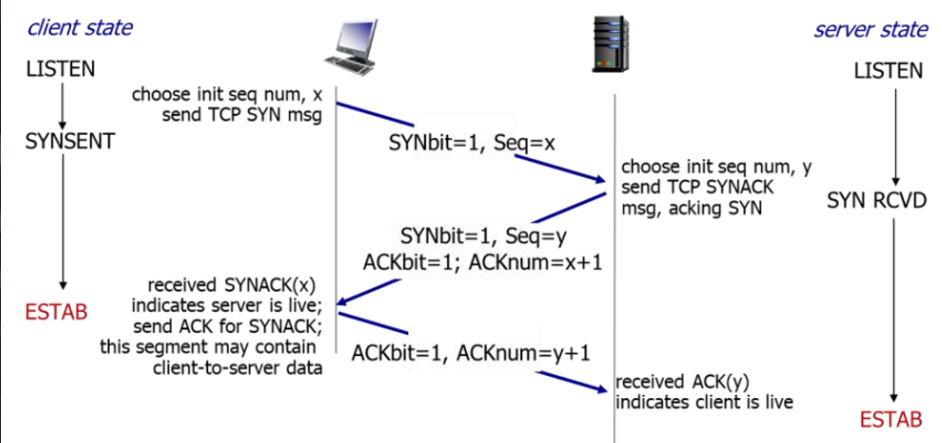
82
New cards
what is connection termination?
either process can end the connection
when connection ends the resources - \[buffers / variables\] in the host are deallocated
when connection ends the resources - \[buffers / variables\] in the host are deallocated
83
New cards
how does connection termination work?
1. client application process issues close command
2. client TCP sends special segment to server
1. FINbit = 1
3. server receives segment and sends an ACK segment for it (where ACKbit = 1)
4. server sends a special shutdown segment
1. FINbit = 1
5. client receives the segment and sends and ACK segment for it
6. resources in the host are deallocated

84
New cards
what is the TCP service - congestion control?
TCP must use ^^end-to-end^^ (between sender and path to receiver) congestion control rather than ^^network-assisted^^ congestion control, since the IP layer provides no explicit feedback to the end systems regarding network congestion
85
New cards
how does congestion control work?
sender limits the rate at which it senders traffic into its connection based on the function of its perceived network congestion
1. perceives little congestion = increase send rate, high congestion = reduce send rate : inverse relationship
2. the TCP perceives the network congestion based on the amount of packet loss and/or **delayed** acknowledgements (high ACK rate = perceived congestion free)
3. congestion-control mechanism at sender manages a variable called congestion window (cwnd)
4. CWND imposes constraints on the rate that the sender can send traffic into the network, the ^^sender cannot send an amount of unacknowledged data^^ into the network that is greater than the minimum value of the congestion window or the receive window
1. perceives little congestion = increase send rate, high congestion = reduce send rate : inverse relationship
2. the TCP perceives the network congestion based on the amount of packet loss and/or **delayed** acknowledgements (high ACK rate = perceived congestion free)
3. congestion-control mechanism at sender manages a variable called congestion window (cwnd)
4. CWND imposes constraints on the rate that the sender can send traffic into the network, the ^^sender cannot send an amount of unacknowledged data^^ into the network that is greater than the minimum value of the congestion window or the receive window
86
New cards
what equation is involved for congestion control?
LastByteSent − LastByteAcked ≤ min{cwnd, rwnd}
87
New cards
what is bandwidth probing?
the TCP sender’s rate increases when receiving ACKs until a loss event occurs, then the transmission rate is decreased
88
New cards
what is additive increase multiplicative decrease
the way bandwidth probing occurs
1. additive increase - cwnd by 1 MSS every RTT until loss detected
2. loss occurs
3. multiplicative decreases the bandwidth - cut cwnd in half after loss
1. additive increase - cwnd by 1 MSS every RTT until loss detected
2. loss occurs
3. multiplicative decreases the bandwidth - cut cwnd in half after loss
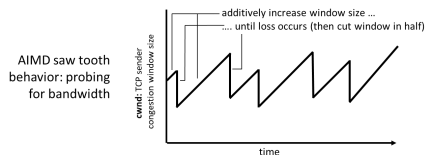
89
New cards
when would we use UDP over TCP?
* application-level control
* minimum sending rate where loss tolerated but not delay
* no connection establishment delay
* no client-server connection state so can manage more request
* smaller size due to smaller 8 byte header vs. 20 byte
* minimum sending rate where loss tolerated but not delay
* no connection establishment delay
* no client-server connection state so can manage more request
* smaller size due to smaller 8 byte header vs. 20 byte
